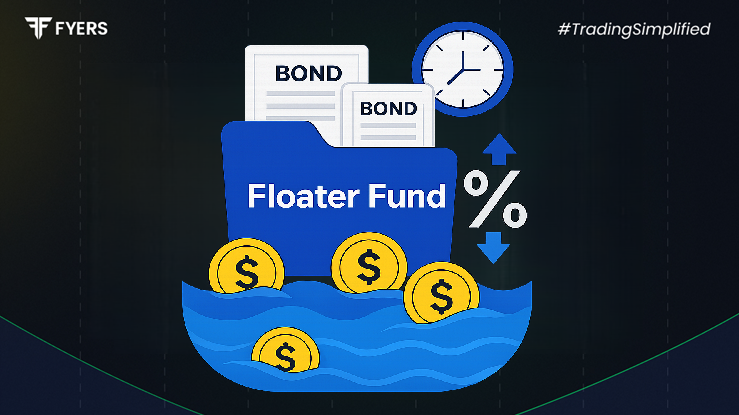

 29 Sep, 2025
29 Sep, 2025
 4 mins read
4 mins read

In the world of mutual funds, debt schemes often attract conservative investors who want stability with moderate returns. Among these, a floater fund has gained attention as an option that adjusts to changing interest rate environments. Unlike fixed-rate debt funds, these schemes primarily invest in securities with floating interest rates, making them more dynamic.
This blog explains what is a floater fund, how it works, its benefits, limitations, and whether it fits into your portfolio.
A floater mutual fund is a type of debt scheme that invests a majority of its assets—at least 65% as mandated by SEBI—in instruments with floating interest rates. These rates are linked to a benchmark, such as the repo rate, MIBOR, or government bond yields.
When interest rates rise, the coupon (interest) on these securities also increases, benefiting the investor. Conversely, when rates fall, returns may decline. This feature makes floater funds more adaptive compared to fixed-rate debt funds.
For example, if a floater debt fund invests in a bond linked to the repo rate, and the RBI raises the repo rate by 50 basis points, the coupon payable on that bond also rises. This protects investors against interest rate risk to some extent.
Floater funds can be categorised based on the securities they hold and their duration profile:
Invest predominantly in floating rate bonds.
Directly benefit when benchmark interest rates rise.
Combine floating rate instruments with fixed-rate debt securities.
The fixed-rate portion may be swapped into floating rates using derivatives, giving flexibility.
Invest in short-duration floating rate instruments.
Lower volatility compared to long-duration floaters.
Hold floating rate bonds with longer maturity.
Carry more sensitivity to rate movements but can generate higher yields during rising rate cycles.
Investing in floater mutual funds offers several advantages:
Protection in Rising Rate Cycles: Floater funds perform better when interest rates increase, as their coupons reset at higher levels.
Diversification: They help diversify a debt portfolio dominated by fixed-rate securities.
Lower Duration Risk: Since interest payouts adjust periodically, these funds reduce sensitivity to interest rate movements compared to traditional debt funds.
Liquidity: Most floater funds allow easy redemption, offering better flexibility than fixed deposits.
Professional Management: Fund managers actively choose a mix of securities, making the fund adaptive to market conditions.
While floater funds have advantages, they are not risk-free. Investors must be aware of potential downsides:
Falling Interest Rates: If rates decline, the coupon income reduces, leading to lower returns.
Credit Risk: As with other debt funds, there is a risk of default if issuers fail to meet obligations.
Liquidity Risk: Some floating rate securities may not be as liquid, which can affect fund performance.
Market Uncertainty: In periods of volatile rate changes, returns may fluctuate sharply.
Thus, floater funds are not suitable for those seeking guaranteed returns.
Floater fund returns depend on the prevailing interest rate environment.
During rising rate cycles, these funds tend to deliver better results than fixed-rate debt funds.
In a falling rate scenario, their performance may lag behind long-term gilt or fixed-rate funds.
Historically in India, floater funds have offered competitive returns in the range of 6–8% annually, but these vary depending on rate cycles, fund manager strategy, and credit quality of underlying securities.
Floater funds are best suited for:
Investors Expecting Rising Interest Rates: These funds provide better protection compared to traditional debt funds in such cycles.
Short-to-Medium-Term Investors: Ideal for those with an investment horizon of 2–3 years.
Conservative Investors Seeking Stability: They can complement fixed deposits while providing liquidity.
Diversified Debt Portfolios: Investors already holding fixed-rate bonds can use floater funds to balance risk.
However, they may not suit ultra-conservative investors who cannot tolerate fluctuating returns.
A floater fund is a unique category of debt mutual funds that adapts to interest rate movements. By investing primarily in floating rate instruments, these funds can deliver attractive returns in rising rate environments while diversifying a fixed-income portfolio.
That said, investors must remain mindful of risks, especially during falling rate cycles, and align their investment horizon with the fund’s strategy. For those comfortable with moderate risk, floater mutual funds can be a valuable addition to their portfolio.
Their coupon payments increase, leading to potentially higher returns for investors.
They can offer better returns and liquidity, but unlike FDs, floater funds carry credit and market risks.
Yes, during sharp market volatility, credit defaults, or falling rate cycles, returns can dip temporarily.
It varies by fund house but typically starts from ₹500 to ₹5,000 for lump sum, and ₹100–₹500 for SIPs.
Calculate your Net P&L after deducting all the charges like Tax, Brokerage, etc.
Find your required margin.
Calculate the average price you paid for a stock and determine your total cost.
Estimate your investment growth. Calculate potential returns on one-time investments.
Forecast your investment returns. Understand potential growth with regular contributions.